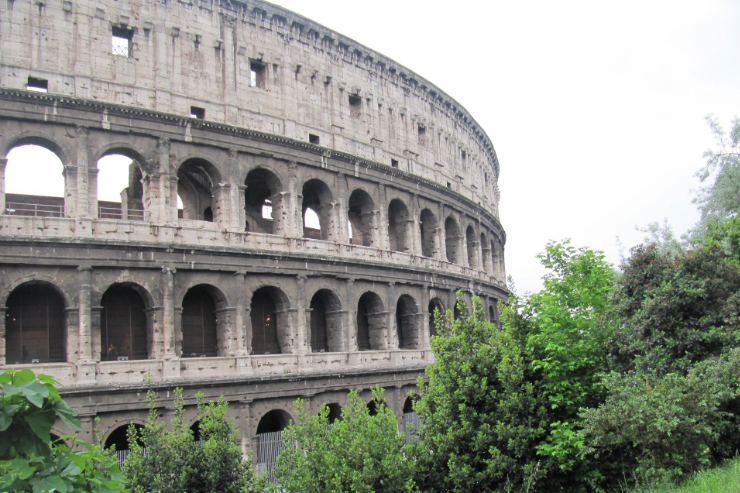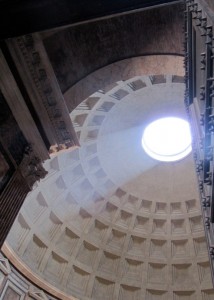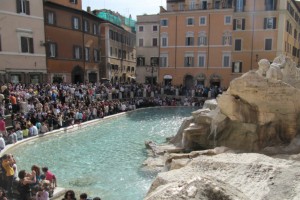One Family’s Novena to Italy—Day Three
by Mark Armstrong | May 9, 2015 12:03 am
 [1]
[1]The Colosseum in Rome
Photography by Mark Armstrong
Travel Journal[2] Day Three, May 9, 2015 — Rome through the ages.
It is impossible to see all the sights that Rome has to offer. But we tried to see as many as possible on our first full day here. We start off at the famous Colosseum in Rome. Most are aware that early Catholics were martyred here. It was a gruesome place. Starting in 70 A.D., Roman emperors, seeking the favor of their subjects, offered free tickets to fifty-five thousand people to come watch everything from mock battles on water (when they flooded the Colosseum) to wild beasts from all over the world who would turn helpless victims into human hamburger. Then there were the poor gladiators fighting to the death with the crowd determining who lived and who died. Blood and carnage was what the crowd wanted to see, smell and watch.
Looking out over the Colosseum this day, I reflected a bit on this as our tour guide gave an excellent hour summary of what took place here. Why is it that all great societies have a flaw of death in them, including our Western society?
One of my passions is to talk and write about the Aztec culture of death and how it ended suddenly with the appearance of Our Lady of Guadalupe to St. Juan Diego[3] in the early 16th century in Mexico.
The Aztecs, while advanced in many ways, were seriously flawed as they conducted human sacrifices from atop their pyramids on an almost incomprehensible scale while crowds cheered below. The Roman and Aztec cultures of death were bloody public displays, supported by the culture of their times.
We have a flaw in our society as well. We allow women to kill the most innocent among us through abortion. Our culture, both in the United States of America and here in Europe demands a woman have the right to kill her own baby. Our culture of death is bound to fall one day, just as the Aztecs did, just as the Romans did.
 [4]
[4]The Oculus of the Roman Pantheon
Photography by Mark Armstrong
After our tour of the Colosseum, we crossed the street to the site of the ruins of emperor palaces, arches, the Roman Forum, and the spot where Julius Caesar was cremated after being murdered by scores of Roman senators on the Ides of March in 44 B.C.
After a break for lunch we see one of my favorites sites, the famous Roman Pantheon with its unique “Oculus.” Nearly two thousand years old, it remains still the world’s largest unreinforced concrete dome. It was converted to a Catholic Church in the seventh century.
Nearby is Trevi Fountain—I can’t help but think of the 1954 romantic comedy, “Three Coins in the Fountain.” A fountain has existed here for more than two thousand years. It took until 1629 before Pope Urban VIII asked Gian Lorenzo Bernini to sketch out a new one. Bernini’s name is more famous for his sculpture work at St. Peter’s and elsewhere. However, both men died before it could be completed. It took Pope Clement XII, through a contest, to get a new fountain going again in 1730. He also died before it could be built, but finally it was finished by Giuseppe Pannini in 1762.
 [5]
[5]Fontana di Trevi
Photography by Mark Armstrong
Trevi is eighty-five feet long and sixty-five feet tall with marble statues and water gushing out all over into a giant pool; it is the largest Baroque fountain in the world. A traditional legend holds that if you throw a coin into the fountain, you are ensured a return trip to Rome. The legend must work because five years ago when we threw coins into Trevi, I never imagined I would be back!
I read in one of the tour guides that coins worth an estimated 5,000 euros (that’s more than 5,600 dollars) are thrown into the fountain each day. The money is fished out by the city and used to subsidize a supermarket for Rome’s poor.
Leaving Trevi, we walk the few winding blocks to find ourselves at the base of the Spanish Steps, the longest and widest staircase in Europe. Beautiful flowers are in bloom in planters that line the steps and people are packed sitting on the steps as they chat, eat gelato and people watch. The stairway of one hundred thirty-eight steps was built in the early 1700’s and links the plaza below to the French Catholic Church,Trinità deiMonti or Holy Trinity, on the hill. Built in the seventeenth and eighteenth centuries, there are beautiful frescoes and marble statues inside to see.
Our final stop is at the Vatican Museum and then to see the famous Sistine Chapel and the artwork of Michelangelo, more on that tomorrow.
- [Image]: http://www.integratedcatholiclife.org/wp-content/uploads/colosseum-rome-armstrong-featured-w740x493.jpg
- Travel Journal: http://www.integratedcatholiclife.org/tag/novena-to-italy/
- write about the Aztec culture of death and how it ended suddenly with the appearance of Our Lady of Guadalupe to St. Juan Diego: http://www.integratedcatholiclife.org/2013/12/mark-armstrong-lady-of-guadalupe-come-to-our-aid/
- [Image]: http://www.integratedcatholiclife.org/wp-content/uploads/pantheon-oculus-armstrong.jpg
- [Image]: http://www.integratedcatholiclife.org/wp-content/uploads/trevi-rome-armstrong-featured-w740x493.jpg
Source URL: https://integratedcatholiclife.org/2015/05/mark-armstrong-one-familys-novena-to-italy-third-day/